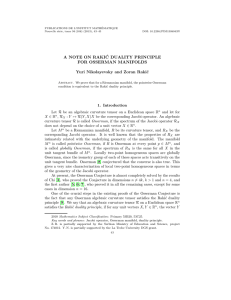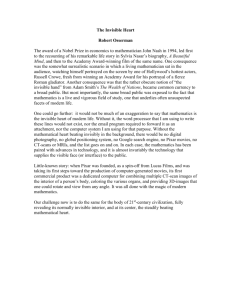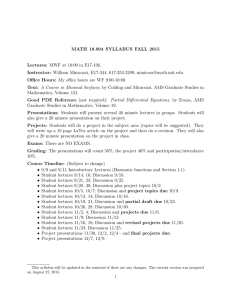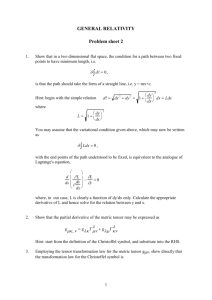PUBLICATIONS DE L’INSTITUT MATHÉMATIQUE Nouvelle série, tome 94 (108) (2013), 197–204
advertisement
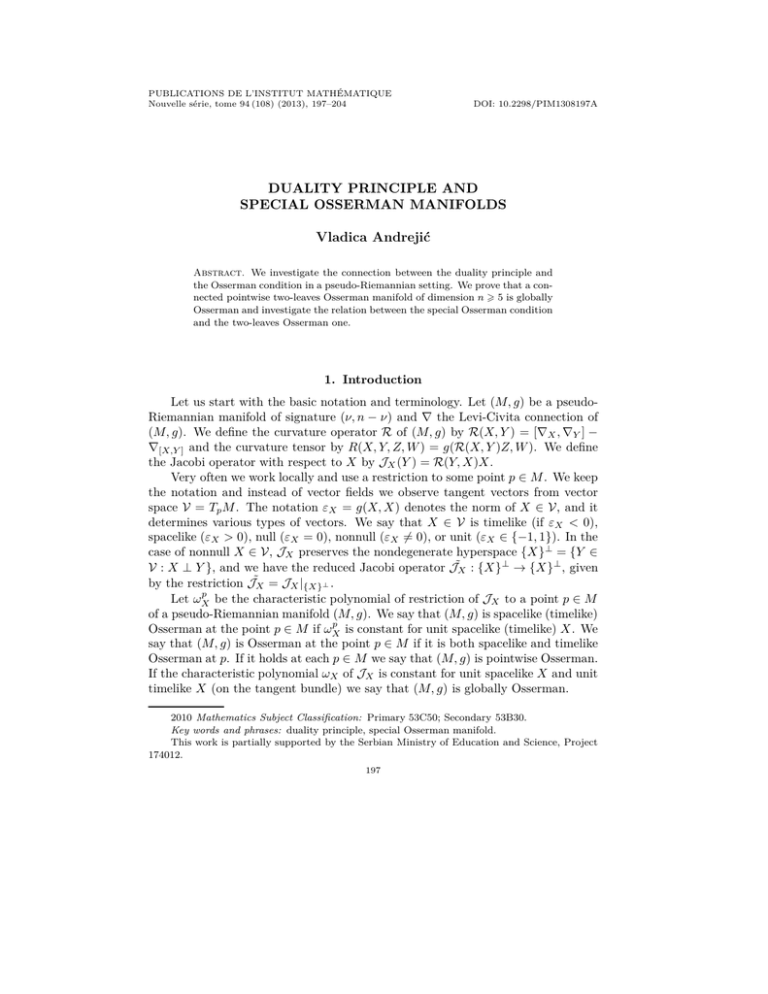
PUBLICATIONS DE L’INSTITUT MATHÉMATIQUE
Nouvelle série, tome 94 (108) (2013), 197–204
DOI: 10.2298/PIM1308197A
DUALITY PRINCIPLE AND
SPECIAL OSSERMAN MANIFOLDS
Vladica Andrejić
Abstract. We investigate the connection between the duality principle and
the Osserman condition in a pseudo-Riemannian setting. We prove that a connected pointwise two-leaves Osserman manifold of dimension n > 5 is globally
Osserman and investigate the relation between the special Osserman condition
and the two-leaves Osserman one.
1. Introduction
Let us start with the basic notation and terminology. Let (M, g) be a pseudoRiemannian manifold of signature (ν, n − ν) and ∇ the Levi-Civita connection of
(M, g). We define the curvature operator R of (M, g) by R(X, Y ) = [∇X , ∇Y ] −
∇[X,Y ] and the curvature tensor by R(X, Y, Z, W ) = g(R(X, Y )Z, W ). We define
the Jacobi operator with respect to X by JX (Y ) = R(Y, X)X.
Very often we work locally and use a restriction to some point p ∈ M . We keep
the notation and instead of vector fields we observe tangent vectors from vector
space V = Tp M . The notation εX = g(X, X) denotes the norm of X ∈ V, and it
determines various types of vectors. We say that X ∈ V is timelike (if εX < 0),
spacelike (εX > 0), null (εX = 0), nonnull (εX 6= 0), or unit (εX ∈ {−1, 1}). In the
case of nonnull X ∈ V, JX preserves the nondegenerate hyperspace {X}⊥ = {Y ∈
V : X ⊥ Y }, and we have the reduced Jacobi operator J˜X : {X}⊥ → {X}⊥ , given
by the restriction J˜X = JX |{X}⊥ .
p
Let ωX
be the characteristic polynomial of restriction of JX to a point p ∈ M
of a pseudo-Riemannian manifold (M, g). We say that (M, g) is spacelike (timelike)
p
Osserman at the point p ∈ M if ωX
is constant for unit spacelike (timelike) X. We
say that (M, g) is Osserman at the point p ∈ M if it is both spacelike and timelike
Osserman at p. If it holds at each p ∈ M we say that (M, g) is pointwise Osserman.
If the characteristic polynomial ωX of JX is constant for unit spacelike X and unit
timelike X (on the tangent bundle) we say that (M, g) is globally Osserman.
2010 Mathematics Subject Classification: Primary 53C50; Secondary 53B30.
Key words and phrases: duality principle, special Osserman manifold.
This work is partially supported by the Serbian Ministry of Education and Science, Project
174012.
197
198
ANDREJIĆ
In a pseudo-Riemannian setting, the Jordan normal form plays a crucial role,
since the characteristic polynomial does not determine the eigen-structure of a
symmetric linear operator. We say that (M, g) (or its curvature tensor R) is a
Jordan–Osserman if the Jordan normal form of JX is constant on both pseudospheres. Diagonalizable Osserman is a special case of Jordan–Osserman such that
all Jordan blocks have size 1 (Jacobi operator JX is diagonalizable for all nonnull X). Diagonalizability is a natural Riemannian-like condition, moreover, it
is known that every Jordan–Osserman curvature tensor of non-neutral signature
(n 6= 2ν) is necessarily diagonalizable [15].
It is worth to emphasize that the spacelike and timelike Osserman conditions
at any point are equivalent [12]. However, an analogous result is no longer true
for the spacelike and timelike Jordan–Osserman conditions, which are equivalent
in dimension four [11].
In the Riemannian setting (ν = 0), it is known that a local two-point homogeneous space (flat or locally rank one symmetric space) has a constant characteristic
polynomial on the unit sphere bundle. Osserman wondered if the converse held [20],
and this question has been called the Osserman conjecture by subsequent authors.
During the solving of some particular cases of the conjecture, the implication
(1.1)
JX (Y ) = λY ⇒ JY (X) = λX
appeared naturally, and if it holds, it can significantly simplify some calculations.
The first results in this topic were given by Chi [10], who proved the conjecture in
the cases of dimensions n 6= 4k, k > 1. In his work he used the statement that (1.1)
holds, if λ is an extremal (minimal or maximal) eigenvalue of the Jacobi operator.
Rakić used implication (1.1) to formulate the duality principle for Osserman
manifolds and proved it in the Riemannian setting [21]. After that, the duality
principle is reproved by Gilkey [14], and it becomes a beneficial tool for the conjecture solution. Moreover, Nikolayevsky used the duality principle [17] to prove
the Osserman conjecture in all dimensions, except some possibilities in dimension
n = 16 [16–18].
It is interesting to investigate the converse of Rakić’s theorem. Can we prove
that (M, g) is (pointwise) Osserman if and only if the duality principle holds? We
proved [1, 3] that this is true in dimension n = 3 and for some cases related with
Fiedler’s tensors. Recently Brozos-Vázquez and Merino [9] proved that this is true
for the Riemannian manifolds of dimension 4. Finally, Nikolayevsky and Rakić [19]
gave the affirmative answer to our question in the Riemannian setting.
The generalization of the Osserman conjecture has appeared in a pseudoRiemannian setting. For example, in the Lorentzian setting (ν = 1), an Osserman
manifold necessarily has a constant sectional curvature [6]. Investigation of Osserman manifolds of signature (2, 2) becomes very popular, and it is worth to mention
results from [7], which are based on the discussion of possible Jordan normal forms
of the Jacobi operator.
The above results provide us with a good motivation and this is why we started
to examine the duality principle for Osserman manifolds in a pseudo-Riemannian
DUALITY PRINCIPLE AND SPECIAL OSSERMAN MANIFOLDS
199
setting. Implication (1.1) in a pseudo-Riemannian setting looks inaccurate, and
therefore we corrected it in the following way [1, 5].
Definition 1.1 (Duality principle). We say that the duality principle holds
for a curvature tensor R if for all mutually orthogonal units X, Y ∈ V, and for all
λ ∈ R there holds
(1.2)
JX (Y ) = εX λY ⇒ JY (X) = εY λX.
Sometimes it is desirable to use a larger domain for our condition of (1.2),
especially if we deal with the converse (of Rakić theorem) problem. We say that
the strong duality principle holds for a curvature tensor R if for all X, Y ∈ V with
εX 6= 0, and for all λ ∈ R equation (1.2) holds [2]. This domain (for X and
Y ) cannot be extended to εX = 0, because there exists a 4-dimensional globally
Jordan–Osserman manifold such that formula (1.2) does not work at every point [2].
However, it is known that the duality principle and the strong duality principle are
equivalent in the diagonalizable case [2, 5].
The (strong) duality principle for Osserman manifolds works nicely for every
known example, however we failed to prove it in general. In our previous work
[1,2,5] we gave the affirmative answer only for the conditions of small index (ν 6 1)
or low dimension (n 6 4). In this paper, we restrict our attention to small number
of eigenvalues of the reduced Jacobi operator.
2. Two-leaves Osserman manifolds
Let us look at small number of eigenvalues of the reduced Jacobi operator. The
simplest case is a diagonalizable Osserman curvature tensor whose reduced Jacobi
operator has a single eigenvalue, and it has to be a real space form (a manifold
of constant sectional curvature) [13]. This is the reason why we look at the first
nontrivial case, diagonalizable Osserman curvature tensor whose reduced Jacobi
operator has two distinct eigenvalues, and we call it two-leaves Osserman.
Definition 2.1 (Two-leaves Osserman). Let R be an Osserman curvature tensor on a vector space V of the signature (ν, n−ν), such that reduced Jacobi operator
J˜X is diagonalizable with exactly two distinct eigenvalues εX λ and εX µ for every
nonnull X ∈ V. Then we say that R is two-leaves Osserman.
It is well known [14] that R is Osserman if and only if it is k-stein for every
k ∈ N. This is why for pointwise Osserman manifold and each k ∈ N there exist
smooth functions Cj : M → R with
Tr(JX j ) = (εX )j Cj (p)
at each p ∈ M , for every X ∈ Tp M and 1 6 j 6 k. The question if functions Cj
are constant is known as the Schur-like problem. We recall results for a connected
pseudo-Riemannian manifold (M, g) of dimension n: if (M, g) is Einstein (1-stein)
and n 6= 2 then C1 is constant; if (M, g) is zweistein (2-stein) and n 6∈ {2, 4} then
C2 is constant [14]. We are ready now for the proof of the following theorem.
200
ANDREJIĆ
Theorem 2.1. If (M, g) is a connected pointwise two-leaves Osserman manifold of dimension n > 5, then (M, g) is a globally Osserman.
Proof. Let (M, g) be a connected two-leaves Osserman manifold such that
the reduced Jacobi operator J˜X has exactly two distinct eigenvalues εX λ(p) and
εX µ(p) with multiplicities σ(p) and τ (p) respectively. The condition n > 5 excludes
undesirable cases and we have constant C1 and C2 . However, for every j we have
(εX )j Cj (p) = Tr(JX j ) = (εX )j (σ(p)λ(p)j + τ (p)µ(p)j ).
Let us set C0 = n − 1 and look at the system of equations for j ∈ {0, 1, 2}:
σ(p) + τ (p) = C0 ,
σ(p)λ(p) + τ (p)µ(p) = C1 ,
σ(p)λ(p)2 + τ (p)µ(p)2 = C2 .
From the first two equations we have
σ=
C1 − C0 µ
C1 − C0 λ
, τ=
,
λ−µ
µ−λ
and after the substitution into the third equation
C1 (λ + µ) − C0 λµ = C2 .
It is clear that τ > 1, thus C1 − C0 λ 6= 0, and the previous equation gives
µ=
C2 − C1 λ
.
C1 − C0 λ
The other functions can be expressed in terms of λ in the following way
σ=
C0 C2 − C12
(C1 − C0 λ)2
, τ=
.
2
C0 λ − 2C1 λ + C2
C0 λ2 − 2C1 λ + C2
The variant of this theorem in [13] requires that the multiplicities σ(p) and
τ (p) are constant, however we shall see that this condition is not necessary. The
basic argument of this original result is that σ is an integer by definition.
From the previously derived relation between σ and λ, we see that a concrete σ
gives at most two values for λ, which are solutions of the related quadratic equation.
Values for σ are integers 1 6 σ 6 n − 2, and therefore λ can get at most 2(n − 2)
concrete values.
From Cj (p) = σ(p)λ(p)j + τ (p)µ(p)j , we can see that Cj (p) for j > 2 can get at
most 2(n−2) concrete values. The function Cj (p) is smooth, so it is continuous, and
therefore it can get exactly one value, hence Cj are necessarily constant. Thus, all
functions (σ, τ , λ, and µ) are constant, which proves that the manifold is globally
Osserman.
It is worth noting that our theorem holds without diagonalizability for the
reduced Jacobi operator from the definition of the two-leaves Osserman (Definition
2.1). It is clear that our proof does not depend on the possible Jordan blocks, so we
should check only cases with a complex eigenvalue. The existence of complex zero
DUALITY PRINCIPLE AND SPECIAL OSSERMAN MANIFOLDS
201
α(p) + iβ(p) of the characteristic polynomial of the reduced Jacobi operator implies
that its conjugate α(p) − iβ(p) is also a zero with the same multiplicity n−1
2 .
At the first sight, we can notice that n is odd, so the signature is not neutral
and in a case of Jordan–Osserman manifold, by [15] we have a diagonalizable
case anyway. Of course, we can do straightforward calculations to get constant
C1 = (n − 1)α(p) and C2 = (n − 1)(α(p)2 − β(p)2 ), and therefore α(p) and β(p)
are constant, too. Constant α and β give constant eigenvalues and hence we have
a globally Osserman manifold.
Since we proved that the strong duality principle holds for pointwise Osserman
manifold of dimension n 6 4 [2], Theorem 2.1 said that a globally Osserman condition can not help us in the case of the two-leaves Osserman manifold. This is why
we can put the problem into a pure algebraic concept with an algebraic Osserman
curvature tensor instead of working with an Osserman manifold and the associated
tangent bundles.
3. Special Osserman manifolds
The diagonalizability and the fact that JX has only two eigenvalues (εX λ and
εX µ) gives an orthogonal decomposition of the vector space V for every nonnull X:
V = Span{X} ⊕ Ker(J˜X − εX λ Id) ⊕ Ker(J˜X − εX µ Id)
Let us introduce the following short notation for some important subspaces and
their dimensions.
L(X) = Ker(J˜X − εX λ Id),
dim L(X) = τ
M(X) = Ker(J˜X − εX µ Id), dim M(X) = σ
U(X) = Span{X} ⊕ L(X),
dim U(X) = τ + 1 = n − σ
Since each eigenspace of a self-adjoint diagonalizable linear operator is nondegenerate, all mentioned subspaces are nondegenerate. The previous decomposition can
be written as
V = Span{X} ⊕ L(X) ⊕ M(X) = U(X) ⊕ M(X),
and an arbitrary Y ∈ V can be decomposed as
Y = ξX + YL + YM ,
where YL ∈ L(X) and YM ∈ M(X). The vectors X, YL , and YM are all mutually
orthogonal, and we denote relevant projections by
ΠL (X, Y ) = YL , ΠM (X, Y ) = YM , ΠU (X, Y ) = ξX + YL .
Many known examples of the two-leaves Osserman curvature tensors have something in common, which motivates us to introduce some additional conditions.
Definition 3.1 (Quasi-special Osserman). We say that R is quasi-special Osserman if it is two-leaves Osserman and for all nonnull X, Y ∈ V there holds
(3.1)
Y ∈ U(X) ⇒ U(X) = U(Y ).
202
ANDREJIĆ
Definition 3.2 (Special Osserman). We say that R is special Osserman if it
is quasi-special Osserman and for all nonnull X, Z ∈ V there holds
(3.2)
Z ∈ M(X) ⇒ X ∈ M(Z).
García-Río and Vázquez-Lorenzo introduced the concept of special Osserman
manifolds [8, 13]. In our terminology their original definition can be viewed as
Definition 3.2, which means that a manifold is two-leaves Osserman with the additional conditions (3.1) and (3.2). They managed to find the complete classification
of special Osserman manifolds [8, 13]. Let us recall this results.
Theorem 3.1 (García-Río, Vázquez-Lorenzo). Complete and simply connected
special Osserman manifold is isometric to one of the following:
1) an indefinite complex space form of signature (2k, 2r), k, r > 0,
2) an indefinite quaternionic space form of signature (4k, 4r), k, r > 0,
3) paracomplex space form of signature (k, k)
4) a paraquaternionic space form of signature (2k, 2k), or
5) a Cayley plane over the octaves with definite or indefinite metric tensor, or a
Cayley plane over the anti-octaves with indefinite metric tensor of signature (8, 8).
Let us remark that special Osserman curvature tensors are not the only examples of the two-leaves Osserman. For example, let V be a vector space furnished
with a metric g and a quaternionic structure, where {J1 , J2 , J3 = J1 J2 } is a canonical basis of that quaternionic structure. Let us define a curvature operator by
R = RJ1 + RJ2 , where
RJ (X, Y )Z = g(JX, Z)JY − g(JY, Z)JX + 2g(JX, Y )JZ
presents one of the first examples of an Osserman curvature operator. The associated curvature tensor of so defined R is a diagonalizable Osserman, whose reduced
Jacobi operator has exactly two distinct eigenvalues: λ = −3 (with multiplicity
τ = 2) and µ = 0. Therefore it is the two-leaves Osserman curvature tensor.
However, since for every unit X
U(X) = Span{X, J1 X, J2 X} 6= Span{X, J1 X, J3 X} = U(J1 X),
it is not quasi-special Osserman.
At the first sight it seems that there are too many conditions in the definition
of a special Osserman curvature tensor. However, additional condition (3.2) which
made quasi-special Osserman to be special Osserman, is the duality principle for
the value µ. Let us note that eigenspaces L(X) and M(X) play different roles now,
and that the duality principle for the value λ is already included in condition (3.1).
The main goal in our previous work [1,4] was to examine if quasi-special Osserman curvature tensors are necessarily special Osserman. Can we prove that strong
quasi-special Osserman condition implies the duality principle? Unfortunately, we
have not completely answered this question.
We managed to prove that if there is a counterexample, then we have a nonnull
A and nonnull B, C ∈ M(A) such that the subspaces H = {ΠM (B, X) : X ∈
U(C)}, and Z = U(B) ∩ U(C) are totally isotropic spaces (they consist just of null
DUALITY PRINCIPLE AND SPECIAL OSSERMAN MANIFOLDS
vectors) of the same dimension dim Z = dim H =
we introduce the following definition.
τ +1
2 .
203
For final result from [1, 4]
Definition 3.3 (Almost-special Osserman). We say that R is almost-special
Osserman if it is two-leaves Osserman and for all nonnull X, Y ∈ V holds
U(X) ∩ U(Y ) 6= 0 ⇒ U(X) = U(Y ).
Any special Osserman curvature tensor is an almost-special Osserman, and any
almost-special Osserman curvature tensor is a quasi-special Osserman. An almostspecial Osserman curvature tensor allows only trivial intersections of U spaces, and
consequently dim Z = 0, so the following theorem holds.
Theorem 3.2. Almost-special Osserman curvature tensor is special Osserman.
At the end, let us give our final remark. The duality principle for an Osserman
curvature tensor is a very hard problem. We do not know any counterexample,
although we failed to prove the duality principle, even under very strong additional
conditions. It seems that a solution of our quasi-special Osserman problem is not
far away, because of the strange looking relation dim Z = dim H = τ +1
2 . For
example, it immediately solves the problem in the case of even τ . This is why we
hope for an affirmative answer of the problem in our future investigations.
References
1. V. Andrejić, Duality principle for Osserman manifolds, PhD thesis, University of Belgrade,
2010 (in Serbian).
2.
, Strong duality principle for four-dimensional Osserman manifolds, Kragujevac
J. Math. 33 (2010), 17–28.
, On certain classes of algebraic curvature tensors; in: Branko Dragovich, Zoran
3.
Rakić (eds). Proc. 5th Math. Phys. Meeting: Summer School and Conference on Modern
Mathematical Physics, 6–17 July 2008, Belgrade, Serbia, Institute of Physics, Belgrade, 2009,
43–50.
4.
, Quasi-special Osserman manifolds, preprint, 2008.
5. V. Andrejić, Z. Rakić, On the duality principle in pseudo-Riemannian Osserman manifolds,
J. Geom. Phys. 57 (2007), 2158–2166.
6. N. Blažić, N. Bokan, P. Gilkey A Note on Osserman Lorentzian manifolds, Bull. London
Math. Soc. 29 (1997), 227–230.
7. N. Blažić, N. Bokan, Z. Rakić Osserman pseudo-Riemannian manifolds of signature (2, 2),
J. Austral. Math. Soc. 71 (2001), 367–395.
8. A. Bonome, P. Castro, E. García-Río, L. Hervella, R. Vázquez-Lorenzo, Pseudo-Riemannian
manifolds with simple Jacobi operators, J. Math. Soc. Japan 54(4) (2002), 847–875.
9. M. Brozos-Vázquez, E. Merino, Equivalence between the Osserman condition and the Rakić
duality principle in dimension 4, J. Geom. Phys. 62 (2012), 2346–2352.
10. Q. Chi, A curvature characterization of certain locally rank-one symmetric spaces, J. Diff.
Geom. 28 (1988), 187–202.
11. E. García-Río, P. Gilkey, M. E. Vázquez-Abal, R. Vázquez-Lorenzo, Four-dimensional Osserman metrics of neutral signature, Pacific J. Math. 244 (2010), 21Ű-36.
12. E. García-Río, D. N. Kupeli, M. E. Vázquez-Abal, R. Vázquez-Lorenzo, Affine Osserman connections and their Riemann extensions, Differential Geom. Appl. 11 (1999), 145Ű-153.
13. E. García-Río, D. N. Kupeli, R. Vázquez-Lorenzo, Osserman manifolds in semi-Riemannian
Geometry, Springer-Verlag, 2002.
204
ANDREJIĆ
14. P. Gilkey, Geometric Properties of Natural Operators Defined by the Riemann Curvature
Tensor, World Scientific, 2001.
15. P. Gilkey, R. Ivanova, Spacelike Jordan–Osserman algebraic curvature tensors in the higher
signature setting, Differential Geometry, Valencia 2001, World Scientific, 2002, 179–186.
16. Y. Nikolayevsky Osserman manifolds of dimension 8, Manuscripta Math. 115 (2004), 31–53.
17.
, Osserman conjecture in dimension n 6= 8, 16, Math. Ann. 331 (2005), 505–522.
, On Osserman manifolds of dimension 16; in: Contemporary Geometry and Related
18.
Topics, Proc. Conf., Belgrade, 2006, 379–398.
19. Y. Nikolayevsky, Z. Rakić A note on Rakić duality principle for Osserman manifolds, Publ.
Inst. Math., Nouv. Sér. 94(108) (2013), 43–45; arXiv:1204.1600 [math.DG].
20. R. Osserman, Curvature in the eighties, Amer. Math. Monthly 97 (1990), 731–756.
21. Z. Rakić On duality principle in Osserman manifolds, Linear Algebra Appl. 296 (1999),
183–189.
Faculty of Mathematics
University of Belgrade
Belgrade
Serbia
andrew@matf.bg.ac.rs
